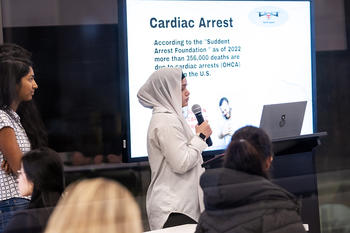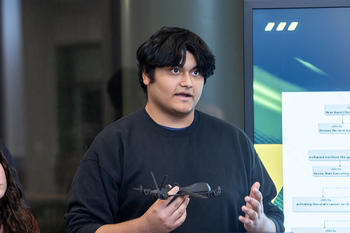“Imagine a time when hearing the buzz of a drone is not a sound of fear, or annoyance, but instead a sound of hope,” said Dallia Laban, an electrical engineering major at George Mason University.

Laban provided the opening to her team’s proposed drone innovation: a CPR drone they’ve named Skylife Support. This drone, they explained, could be deployed by first responders to reach patients and provide emergency CPR while an ambulance is enroute. After their four-minute presentation, a panel of judges asked them about growth projections and certification requirements. The audience applauded, the team returned to their seats, and the next team began their presentation on a drone system that could filter air to combat post-wildfire pollution.
Christopher Vo calls this a “Shark-Tank style pitch competition,” which closes out his Unmanned Aerial Systems Prototyping course. The Fall 2023 course marks the third successful semester of the course’s programming.
Vo is a two-time Mason alum, receiving both his MS in Computer Science ’07 and PhD in Computer Science ’14. After graduating with his PhD, Vo co-founded Sentian Robotics and served as its chief scientist until earlier this year. Sentian Robotics develops novel drone technology, such as the Hive—a drone fleet aircraft carrier.
In addition to being an accomplished robotics scientist, Vo also has a passion for teaching. “I’ve always wanted to bring drones and other new technologies out of the labs and into the real world,” he said. This course allows him to get back into the classroom and bring his knowledge as a start-up owner and robotics professional to a new cohort of students each semester. This kind of partnership is a hallmark of Mason’s entrepreneurial approach, which earned it the top ranking among public universities for research performance in entrepreneurship.
The masterclass, hosted by the Mason Innovation Exchange (MIX), is an eight-week program that meets every Thursday evening throughout October and November. Out of 300 applicants, only 30 students are selected to participate. They represent a wide range of degree programs and education levels, from first-semester freshmen in the Global Affairs Program to graduating PhDs in mechanical engineering. While the course is noncredit, students earn a microcredential upon completion.
Of course, the appeal of a course like this is in the drones. Building a drone and learning to pilot the drones is what inspires most students to apply. But Vo emphasizes that drone construction and piloting is only a small part of the overall course.
“The program is more about how you can use this technology in the real world, so the course is built around our students developing a solution to a real-world problem in first response and law enforcement using drone technology and pitching that solution to stakeholders.”
Students are put into teams based on their degree programs—Vo ensures an equal distribution of engineers and humanities students, as well as diversity of degree level amongst each team. While learning the technology and building a drone, teams must decide on a problem to tackle, theorize a solution, develop a prototype, and pitch their idea to stakeholders.
While learning the nuances of drone building and piloting, students heard from Steve Burmeister of Mason’s Forensic Science Program on emergency preparedness, and Kerin Hilker-Balkissoon, the director of educational and career pathways in the College of Science, on microcredentialing.

Before the pitch competition, students learn the foundations of pitching from Lisa Shapiro, assistant director of entrepreneurship programs in the Office of Research, Innovation, and Economic Impact; Fred Briggs, founder and CEO of Applied Impact Robotics; and Gisele Stolz, senior director of entrepreneurship programs and business incubators in the Office of Entrepreneurship and Economic Development.
The top two groups in the pitch competition receive a monetary prize to be split among team members; the third prize goes to the “People’s Choice.” Students are not allowed to vote for their own design.
This year’s judges include Jordan Higgins, adjunct faculty in Mason’s School of Art and lead human-centered engineer at MITRE; Mike Koontz, MS Computer Engineering ’08 and director of mission technologies at Raytheon; and Kuzeyhan Ozdemir, a seasoned start-up mentor and one of the MIX’s in-house mentors.
Because the course incorporates elements of programming, engineering, creative problem-solving, and entrepreneurship, diversity of thought and skill on each team is critical to teams’ success.
“It’s a unique opportunity for our students to work with truly interdisciplinary teams. They don’t often get the chance to cross-pollinate in standard coursework,” Vo explained. “This course really emphasizes the importance and value of collaboration, cooperation, and learning from other disciplines.”
As of now, the projects end with the conclusion of the course. But Vo hopes to see teams carry on after the course to fully develop their solutions into marketable products.
“We can solve wicked problems through interdisciplinary innovation,” he said. “And that’s what I’m hoping our students take away from this course.”
Read more about entrepreneurship at Mason
- January 5, 2026
- November 20, 2025
- November 18, 2025
- November 11, 2025
- November 4, 2025
